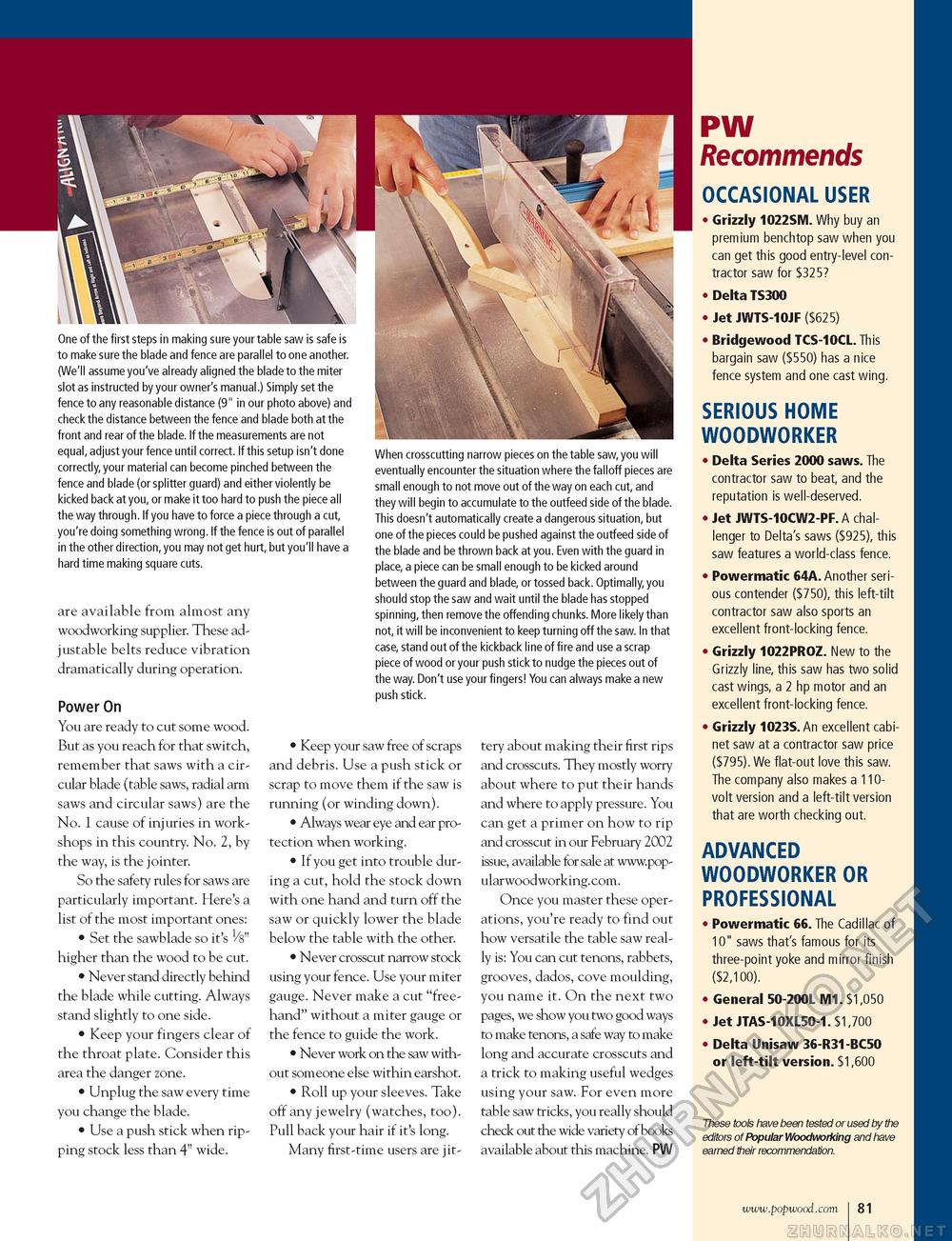Popular Woodworking 2002-10 № 130, страница 81
One of the first steps in making sure your table saw is safe is to make sure the blade and fence are parallel to one another. (We'll assume you've already aligned the blade to the miter slot as instructed by your owner's manual.) Simply set the fence to any reasonable distance (9" in our photo above) and check the distance between the fence and blade both at the front and rear of the blade. If the measurements are not equal, adjust your fence until correct. If this setup isn't done correctly, your material can become pinched between the fence and blade (or splitter guard) and either violently be kicked back at you, or make it too hard to push the piece all the way through. If you have to force a piece through a cut, you're doing something wrong. If the fence is out of parallel in the other direction, you may not get hurt, but you'll have a hard time making square cuts. are available from almost any woodworking supplier. These adjustable belts reduce vibration dramatically during operation. Power On You are ready to cut some wood. But as you reach for that switch, remember that saws with a circular blade (table saws, radial arm saws and circular saws) are the No. 1 cause of injuries in workshops in this country. No. 2, by the way, is the jointer. So the safety rules for saws are particularly important. Here's a list of the most important ones: • Set the sawblade so it's Vs" higher than the wood to be cut. • Never stand directly behind the blade while cutting. Always stand slightly to one side. • Keep your fingers clear of the throat plate. Consider this area the danger zone. • Unplug the saw every time you change the blade. • Use a push stick when ripping stock less than 4" wide. When crosscutting narrow pieces on the table saw, you will eventually encounter the situation where the falloff pieces are small enough to not move out of the way on each cut, and they will begin to accumulate to the outfeed side of the blade. This doesn't automatically create a dangerous situation, but one of the pieces could be pushed against the outfeed side of the blade and be thrown back at you. Even with the guard in place, a piece can be small enough to be kicked around between the guard and blade, or tossed back. Optimally, you should stop the saw and wait until the blade has stopped spinning, then remove the offending chunks. More likely than not, it will be inconvenient to keep turning off the saw. In that case, stand out of the kickback line of fire and use a scrap piece of wood or your push stick to nudge the pieces out of the way. Don't use your fingers! You can always make a new push stick. • Keep your saw free of scraps and debris. Use a push stick or scrap to move them if the saw is running (or winding down). • Always wear eye and ear protection when working. • If you get into trouble during a cut, hold the stock down with one hand and turn off the saw or quickly lower the blade below the table with the other. • Never crosscut narrow stock using your fence. Use your miter gauge. Never make a cut "freehand" without a miter gauge or the fence to guide the work. • Never work on the saw without someone else within earshot. • Roll up your sleeves. Take off any jewelry (watches, too). Pull back your hair if it's long. Many first-time users are jit- tery about making their first rips and crosscuts. They mostly worry about where to put their hands and where to apply pressure. You can get a primer on how to rip and crosscut in our February 2002 issue, available for sale at www.pop-ularwoodworking.com. Once you master these operations, you're ready to find out how versatile the table saw really is: You can cut tenons, rabbets, grooves, dados, cove moulding, you name it. On the next two pages, we show you two good ways to make tenons, a safe way to make long and accurate crosscuts and a trick to making useful wedges using your saw. For even more table saw tricks, you really should check out the wide variety of books available about this machine. PW PW Recommends OCCASIONAL USER • Grizzly 1022SM. Why buy an premium benchtop saw when you can get this good entry-level contractor saw for $325? • Delta TS300 • Jet JWTS-10JF ($625) • Bridgewood TCS-10CL. This bargain saw ($550) has a nice fence system and one cast wing. SERIOUS HOME WOODWORKER • Delta Series 2000 saws. The contractor saw to beat, and the reputation is well-deserved. • Jet JWTS-10CW2-PF. A challenger to Delta's saws ($925), this saw features a world-class fence. • Powermatic 64A. Another serious contender ($750), this left-tilt contractor saw also sports an excellent front-locking fence. • Grizzly 1022PROZ. New to the Grizzly line, this saw has two solid cast wings, a 2 hp motor and an excellent front-locking fence. • Grizzly 1023S. An excellent cabinet saw at a contractor saw price ($795). We flat-out love this saw. The company also makes a 110-volt version and a left-tilt version that are worth checking out. ADVANCED WOODWORKER OR PROFESSIONAL • Powermatic 66. The Cadillac of 10" saws that's famous for its three-point yoke and mirror finish ($2,100). • General 50-200L M1. $1,050 • Jet JTAS-10XL50-1. $1,700 • Delta Unisaw 36-R31-BC50 or left-tilt version. $1,600 These tools have been tested or used by the editors of Popular Woodworking and have earned their recommendation. 81 |








